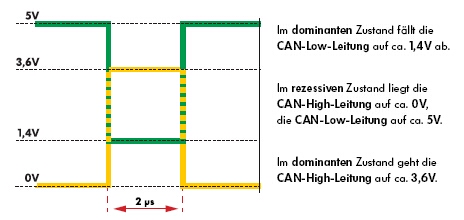

It does not interfere with the rest of the circuit. Under normal operating conditions, the TVS diode presents a high impedance path to the protected circuit, so the device appears as an open circuit. Transient protection can be achieved by placing a Transient Voltage Suppression (TVS) diode on a CAN bus data line to protect against transient events during the fast rise time in less than a nanosecond.

Moreover, with the miniaturization of the electronic components, it is even more essential to protect the components from ESD threats and meet modern-day vehicles' safety and reliability requirements. One of the primary causes of EOS is electrostatic discharge (ESD). When designing a CAN interface system in a harsh automotive environment with 50 to 100 ECUs, ensuring sufficient protection from Electrical Overstress Events (EOS) is imperative. The CAN bus architecture is shown in Figure 1.įigure 1. It converts the transistor-transistor logic (TTL) signal into the actual differential voltage signal for the CAN bus to read and interpret. There is a CAN transceiver that interfaces between the CAN controller and the CAN bus.

The ECU is connected to the CAN bus via a CAN controller, similar to a microcontroller that handles all the necessary data processing activities. One of the wires is called the CAN_Low (CAN_L) and the other, CAN_High (CAN_H), with a data transfer rate of 1Mbit/s. A twisted pair cable with a characteristic impedance of 120Ω is used to transmit the data.
CAN BUS HIGH AND LOW SERIAL
It is a bi-directional serial communication bus that allows ECUs to communicate without using any complex wiring. The most popular communication mechanism in modern vehicles is the Controller Area Network (CAN) bus. There are several in-vehicle network (IVN) protocols for data transmission between ECUs inside a vehicle. For example, if you forget your car key in the ignition, the corresponding engine control ECU communicates with the door ECU to keep the door open and the speaker ECU to sound the alarm. Sometimes one ECU may need to communicate with other ECUs to perform a designated function. It receives information from the sensors and adjusts the vehicle parameters under control accordingly. The ECU works with multiple sensors such as the engine temperature sensor, air pressure sensor, door sensor, etc. In a modern vehicle, there are about 50 - 100 ECUs, with each ECU responsible for one or more functions. Advanced features such as GPS navigation, interior mood lighting, surround-view camera, advanced infotainment system, active antenna are standard in most modern vehicles.Įach vehicle feature is usually monitored and controlled by an individual Electronic Control Unit (ECU). Modern cars include autonomous and semi-autonomous driving, anti-lock braking systems, electric power steering, forward and rear collision warning, lane assistant, autonomous parking assistant, and automatic emergency braking. Motor vehicles have gone through much progress since their inception.


 0 kommentar(er)
0 kommentar(er)
